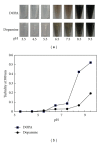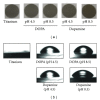Immobilization of bone morphogenetic protein on DOPA- or dopamine-treated titanium surfaces to enhance osseointegration
- PMID: 24459666
- PMCID: PMC3888698
- DOI: 10.1155/2013/265980
Immobilization of bone morphogenetic protein on DOPA- or dopamine-treated titanium surfaces to enhance osseointegration
Abstract
Titanium was treated with 3,4-dihydroxy-L-phenylalanine (DOPA) or dopamine to immobilize bone morphogenetic protein-2 (BMP2), a biomolecule. DOPA and dopamine solutions turned into suspensions, and precipitates were produced at high pH. Both treatments produced a brown surface on titanium that was thicker at high pH than low pH. Dopamine produced a thicker layer than DOPA. The hydrophobicity of the surfaces increased after treatment with dopamine independent of pH. Furthermore, there were more amino groups in the layers formed at pH 8.5 than pH 4.5 in both treatments. Dopamine treatment produced more amino groups in the layer than DOPA. BMP2 was immobilized on the treated surfaces via a coupling reaction using carbodiimide. More BMP2 was immobilized on surfaces treated at pH 8.5 than pH 4.5 in both treatments. The immobilized BMP induced specific signal transduction and alkali phosphatase, a differentiation marker. Thus, the present study demonstrates that titanium treated with DOPA or dopamine can become bioactive via the surface immobilization of BMP2, which induces specific signal transduction.
Figures







Similar articles
-
BMP2-encapsulated chitosan coatings on functionalized Ti surfaces and their performance in vitro and in vivo.Mater Sci Eng C Mater Biol Appl. 2014 Jul 1;40:1-8. doi: 10.1016/j.msec.2014.03.043. Epub 2014 Mar 26. Mater Sci Eng C Mater Biol Appl. 2014. PMID: 24857458
-
Nanotubes Functionalized with BMP2 Knuckle Peptide Improve the Osseointegration of Titanium Implants in Rabbits.J Biomed Nanotechnol. 2015 Feb;11(2):236-44. doi: 10.1166/jbn.2015.2006. J Biomed Nanotechnol. 2015. PMID: 26349299
-
1-step versus 2-step immobilization of alkaline phosphatase and bone morphogenetic protein-2 onto implant surfaces using polydopamine.Tissue Eng Part C Methods. 2013 Aug;19(8):610-9. doi: 10.1089/ten.TEC.2012.0313. Epub 2013 Jan 16. Tissue Eng Part C Methods. 2013. PMID: 23231507 Free PMC article.
-
[Methods of BMP immobilization and evaluation for Ti-based dental implant surface modification].Beijing Da Xue Xue Bao Yi Xue Ban. 2010 Oct 18;42(5):604-7. Beijing Da Xue Xue Bao Yi Xue Ban. 2010. PMID: 20957023 Review. Chinese.
-
Nano-scale modification of titanium implant surfaces to enhance osseointegration.Acta Biomater. 2019 Aug;94:112-131. doi: 10.1016/j.actbio.2019.05.045. Epub 2019 May 22. Acta Biomater. 2019. PMID: 31128320 Review.
Cited by
-
Craniofacial therapy: advanced local therapies from nano-engineered titanium implants to treat craniofacial conditions.Int J Oral Sci. 2023 Mar 29;15(1):15. doi: 10.1038/s41368-023-00220-9. Int J Oral Sci. 2023. PMID: 36977679 Free PMC article. Review.
-
Polydopamine coating promotes early osteogenesis in 3D printing porous Ti6Al4V scaffolds.Ann Transl Med. 2019 Jun;7(11):240. doi: 10.21037/atm.2019.04.79. Ann Transl Med. 2019. PMID: 31317010 Free PMC article.
-
Immobilization of Growth Factors for Cell Therapy Manufacturing.Front Bioeng Biotechnol. 2020 Jun 19;8:620. doi: 10.3389/fbioe.2020.00620. eCollection 2020. Front Bioeng Biotechnol. 2020. PMID: 32637403 Free PMC article. Review.
-
Nanolayer formation on titanium by phosphonated gelatin for cell adhesion and growth enhancement.Int J Nanomedicine. 2015 Sep 2;10:5597-607. doi: 10.2147/IJN.S82166. eCollection 2015. Int J Nanomedicine. 2015. PMID: 26366080 Free PMC article.
-
Plasma functional polymerization of dopamine using atmospheric pressure plasma and a dopamine solution mist.RSC Adv. 2019 Apr 25;9(23):12814-12822. doi: 10.1039/c8ra10391g. eCollection 2019 Apr 25. RSC Adv. 2019. PMID: 35520781 Free PMC article.
References
-
- Bongio M, van der Beuken JJJP, Leeuwenburgh SCG, Jansen JA. Development of bone substitute materials: from “biocompatible” to ‘instructive’. Journal of Materials Chemistry. 2010;20(40):8747–8759.
-
- Joddar B, Ito Y. Biological modifications of materials surfaces with proteins for regenerative medicine. Journal of Materials Chemistry. 2011;21(36):13737–13755.
-
- Zhou D, Ito Y. Inorganic material surfaces made bioactive by immobilizing growth factors for hard tissue engineering. RSC Advances. 2013;3(28):11095–11106.
-
- Jaiswal N, Haynesworth SE, Caplan AI, Bruder SP. Osteogenic differentiation of purified, culture-expanded human mesenchymal stem cells in vitro. Journal of Cellular Biochemistry. 1997;64(2):295–312. - PubMed
-
- Bi LX, Simmons DJ, Mainous E. Expression of BMP-2 by rat bone marrow stromal cells in culture. Calcified Tissue International. 1999;64(1):63–68. - PubMed
Publication types
MeSH terms
Substances
LinkOut - more resources
Full Text Sources
Other Literature Sources

